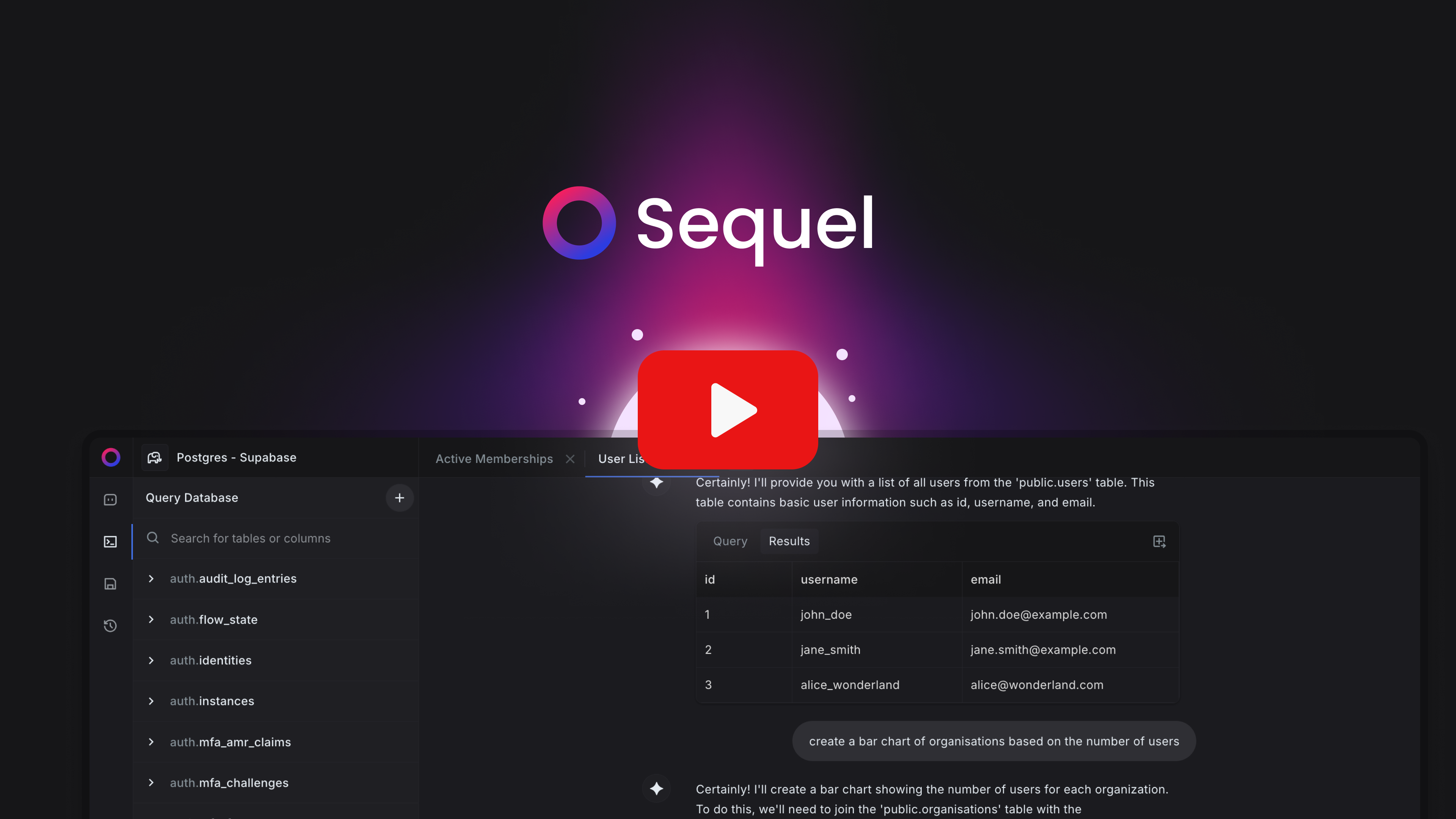Natural Language to SQL: Simplifying Data Access for Everyone

Imagine you’re in a meeting, trying to understand last quarter’s sales performance. You need the data fast, but there’s a problem: you don’t know how to write SQL queries, and your data team is already swamped with requests. You could wait hours—or even days—for the report to be generated. Sound familiar?
This is a common scenario in many businesses today. Accessing data often requires technical expertise, which can slow down decision-making and leave non-technical teams in the dark.
For years, businesses have relied on centralized IT or data teams to handle the heavy lifting of data analysis. While these teams are essential, their workload often creates bottlenecks, making it harder for the rest of the company to act quickly.
Enter Natural Language to SQL.
Now, anyone can ask data-related questions in plain English, and AI will generate the SQL queries needed to pull the relevant information. No coding, no waiting—just instant insights.
This shift in how we interact with data is transforming the workplace, empowering teams to access critical insights without the need for technical skills.
Let’s dive deeper into how Natural Language to SQL works and how it’s helping businesses unlock the full potential of their data.
What is Natural Language to SQL?
Natural Language to SQL (NL to SQL) refers to the technology that allows users to ask questions about their data in plain language, and receive responses in the form of SQL queries.
Something like this -

Typically, writing and optimizing SQL queries requires a deep understanding of the syntax and database structure, which can be a barrier for non-technical users.
Natural Language to SQL eliminates this barrier by enabling anyone to ask questions in a natural, conversational way, while the system generates the corresponding SQL queries behind the scenes.
This breakthrough in technology democratizes access to data, allowing more employees to extract insights and make informed decisions.
Why is Natural Language to SQL Important?
In the past, data analysis was the responsibility of specialized IT or data teams. They handled everything from data extraction to report generation.
These processes were centralized and often took days or even weeks, slowing down business decisions. Only a select few had access to the data, which made it hard for teams to work autonomously.
As businesses began to demand faster, more agile decision-making, traditional tools struggled to keep up. The bottleneck created by reliance on data experts was evident, and businesses needed a solution that allowed more employees to interact with data directly.
Today, businesses require tools that provide real-time insights that can be accessed by anyone across the organization—not just data experts.
Natural Language to SQL is important because it removes these bottlenecks. Here’s why:
- Accessibility: Non-technical users can ask questions about their data without needing to know SQL.
- Speed: Real-time insights can be obtained quickly, bypassing the need for complex query-building processes.
- Scalability: As companies grow, more teams need access to data. NL to SQL allows businesses to scale their data operations without needing to scale their data teams.
- Empowerment: Teams can make data-driven decisions independently, reducing the load on data experts.
Also read: Why Traditional Data Tools Are Holding Your Business Back
How Does Natural Language to SQL Work?
The magic behind NL to SQL lies in AI and machine learning technologies.
Here’s a simplified breakdown of how it works:
- Natural Language Processing (NLP): When a user types a question in plain English, the system uses NLP to understand the intent behind the query. This involves breaking down the sentence into its components and understanding the data-related request.
- Query Generation: Once the system understands the user’s intent, it generates an SQL query that corresponds to the request. This involves identifying the relevant data tables, fields, and filters that need to be applied.
- Query Execution: The generated SQL query is then executed on the underlying database, retrieving the necessary data.
- Response: The results are returned to the user in an easy-to-understand format, often in the form of tables, charts, or graphs.
By automating this process, NL to SQL tools eliminate the need for users to understand the technicalities of SQL, making it easier for them to access and analyze their data.
Let’s consider an example to understand how natural language to SQL works
Let’s say a user types in the following request:
Natural Language Input:
“Give me a list of all customers from New York who made purchases last month.”
The NL to SQL converter breaks down the input to understand its key components:
- Subject: Customers
- Attributes: List of customers
- Condition 1: Located in New York
- Condition 2: Made purchases last month
Query Mapping:
- Subject: Customers (maps to the database table “Customers”)
- Attributes: List of customers (maps to the “Name” or relevant columns in the “Customers” table)
- Condition 1: Located in New York (maps to the column “Location”)
- Condition 2: Made purchases last month (maps to the “Purchase Date” column and filters based on the previous month)
Query Generation:
Based on this understanding, the system generates the following SQL query:
SELECT Name
FROM Customers
WHERE Location = 'New York' AND PurchaseDate >= '2023-09-01' AND PurchaseDate <= '2023-09-30';
Execution:
The query is then executed on the database, returning a list of customers from New York who made purchases in the last month.
Common Use Cases for Natural Language to SQL
NL2 SQL can be used across a variety of industries and business functions. Here are a few common use cases:
- Sales and Marketing: Teams can quickly generate reports on sales performance, lead generation, or customer behavior without waiting for the data team.
- Finance: Financial analysts can retrieve data on expenses, revenue, and budget forecasts, allowing for faster financial reporting and analysis.
- Human Resources: HR teams can analyze employee turnover, recruitment metrics, and more by simply asking questions in plain language.
- Operations: Operations managers can track performance metrics, inventory levels, and process efficiency in real-time.
These use cases illustrate how Natural Language to SQL can be applied to everyday business tasks, making it easier for teams to work more efficiently and make data-driven decisions.
Introducing Sequel: The Future of Data Access and Visualization
As businesses continue to evolve, there is an increasing need for user-friendly data solutions that go beyond the limitations of traditional tools.
This is where Sequel comes in.
Sequel is a modern data solution designed to simplify the way businesses interact with their data. With Sequel, users don’t need to know SQL or have any technical expertise. Instead, they can ask questions in plain English, and the system will take care of the rest.
Here’s what Sequel offers:
- Ask Questions in Plain English: Users can simply type their questions in natural language, and Sequel will generate the corresponding SQL queries.
- AI-Powered Insights: Sequel’s AI assistant helps uncover hidden insights in your data that might otherwise go unnoticed.
- Real-Time Insights Without Writing SQL: Get real-time data insights without the need to write or understand SQL. Sequel automates the entire process, saving you time and effort.
- Effortless Data Visualization: Once the data is retrieved, Sequel makes it easy to visualize the results in the form of charts, graphs, and tables, helping you interpret and act on the data.
See it in action here.
Sequel’s powerful yet simple interface makes it a go-to tool for any business looking to democratize data access and improve decision-making.
The Benefits of Using Sequel
By integrating Sequel into your business operations, you can:
- Speed Up Decision-Making: With real-time insights and AI-powered analysis, Sequel allows teams to make faster, data-driven decisions.
- Reduce Dependence on Data Experts: Sequel empowers non-technical users to interact with data directly, reducing the workload on your data teams.
- Improve Collaboration Across Teams: Since Sequel is user-friendly, it can be used by multiple teams, fostering collaboration and enabling everyone to access the data they need.
- Enhance Productivity: By automating the data query process, Sequel saves time and increases productivity across the organization.
Overcoming Challenges in Data Accessibility
Despite the advancements in data technologies, there are still several challenges when it comes to data accessibility:
- Technical Barriers: Traditional SQL requires technical knowledge, which can be a significant barrier for non-experts.
- Time-Consuming Processes: Writing, testing, and executing SQL queries can be a slow process, especially when multiple teams need to access the data.
- Limited Access to Data: In many organizations, only certain teams or individuals have access to data, creating bottlenecks.
Sequel solves these challenges by offering a solution that anyone can use, regardless of their technical expertise.
Wrapping Up!
As AI and machine learning continue to evolve, the future of Natural Language to SQL looks promising. We can expect to see even more advanced AI models that can handle increasingly complex queries and data sets.
Additionally, NL to SQL tools will likely become more integrated into business workflows, making data analysis even more seamless.
For businesses, this means even greater accessibility to data, faster decision-making, and more opportunities to uncover valuable insights.
Sequel takes this transformation one step further by providing a simple, user-friendly platform that streamlines data access and analysis. With Sequel, businesses can unlock the full potential of their data, enabling faster, more informed decision-making across the organization.
As the demand for real-time data insights continues to grow, tools like Sequel will become essential for any business looking to stay competitive. Whether you’re in sales, finance, HR, or operations, Sequel can help you make better decisions, faster.
Start exploring your data with Sequel
Save hours of time writing SQL queries. Get started for free.
